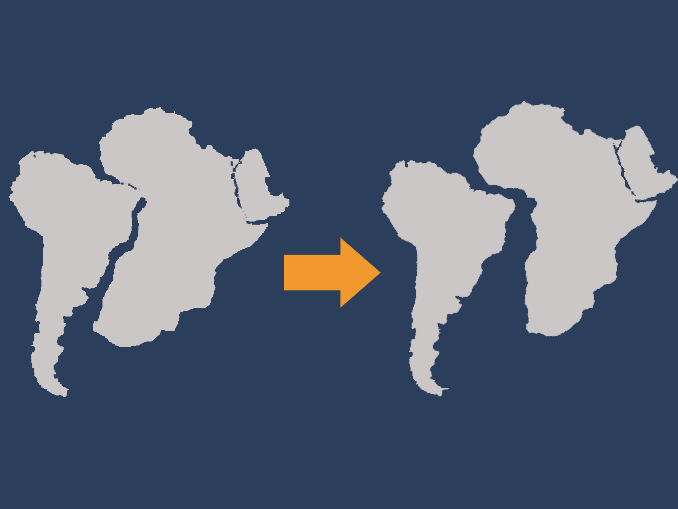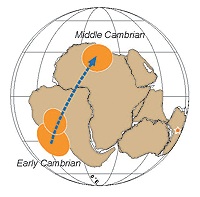Continental drift is a phenomenon which explains how the earth’s continents move on the surface of the ocean bed. Abraham Ortelius was the first geographer who proposed this phenomenon in 1596. The theory was independently developed in 1912 by Alfred Wegener, but it was rejected due to lack of mechanism (which was introduced by Arthur Holmes). The continental drift theory was replaced by the plate tectonic theory which illustrates how the continents drift.
Continental drift is the hypothesis that the Earth's continents have moved over geologic time relative to each other, thus appearing to have 'drifted' across the ocean bed. The speculation that continents might have 'drifted' was first put forward by Abraham Ortelius in 1596. This is an alternative to the Continental plan for 24/7 operations using 8-hr shifts. It reduces the maximum number of consecutive work nights from 3 to 2, and consecutive work days from 7 to 6. The Continental plan, however, provides 3 consecutive days off and ensures 1 free weekend every 4 weeks. Continental Drift. These maps show a succession of two or even three different supercontinents, stretching back over a thousand million years. Not surprisingly the evidence gets increasingly uncertain as we go back in time. A shift occurs when the conditions are right, seismic activity increases and a critical point is reached.Then all hell breaks loose. The tectonic plates shift violently. The volcanic activity at the plate boundaries darken the skies and poison the sea. Part detective story, part report from this economic frontier, Continental Shift follows the money as it flows through Chinese coffers to international conglomerates, to heads of state, to ordinary African citizens, all of whom are intent on defining a metamorphosing continent.
The Continental Drift Theory
The hypothesis of continental drift was developed during the early parts of the twentieth century by Wegener. He believed that all eight continents were once a single supercontinent before separating. A number a geologists denounced his hypothesis after he published it in his book about the origin of oceans and continents in 1915. One of the reasons is that his theory had no credible mechanism. Another problem with Wegener's proposal was the fact that he stated that the velocity of continental drift was 8.202ft/year which is quite high (currently the acceptable rate of continental drift is 0.082ft/year). Wegner was a geographer and not a geologist, and other geologists believed that he did not have sufficient evidence.
Although his observations about the rocks and fossils were correct, Wegener was wrong on various issues. He believed that the continents plowed through the crust of the ocean. Even though the continental drift hypothesis was discarded, it did help introduce the idea of continental movement in geosciences. Decades later, various geologists confirmed some of his ideas including the existence of a super-continent known as Pangaea. Pangaea is believed to have been formed about 250 million years ago.
One of the outstanding questions which Wegener failed to answer was what type of forces propelled the earth’s plates, and this resulted in his hypothesis being opposed by many scientists. Later, a British geologist known as Arthur Holmes championed this theory. In 1931 Holmes proposed that the mantle of the earth has some convention cells which dispersed radioactive heat which drifted the earth’s crust. Jack Oliver provided the seismologic proof which supports the idea of plate tectonic that replaced continental drift in an article which he published in 1968.
Evidence of Continental Drift
Some of the evidence supporting the continental drift of the tectonic plates include the presence of similar animals and plant fossils on the shores of various continents, which suggest that they were once joined. Fossils of a freshwater reptile known as Mesosaurus was found both in South Africa and Brazil. Another piece of evidence is of the discovery of the fossils of Lystrosaurus (a land reptile) on rocks of the same age in Antarctica, India, and Africa. Some of the existing evidence includes numerous earthworm families like Octochaetidae and Acanthodrilidae which are indigenous to both in Africa and South America. The complementary arrangement of the facing sides on Africa and South America is also another evidence which supports the idea of continental drift.
12-hour shifts are pretty common in 24-hour agencies. We found that approximately 41% of law enforcement departments that use PlanIt, schedule with 12-hour shifts.
While they do seem to make scheduling easier, they are not always the best for the officers.
When we went through and evaluated different scheduling trends, we found 7 consistent 12-hour shift schedules.
Too much information? Check out the Top 3 12-Hour Shift Schedules to help you narrow down your options.
- [2 on 3 off] [2 on 2 off] [3 on 2 off]
- [4 on 3 off] [3 on 4 off] and [3 on 3 off] [4 on 4 off]
- [4 on 4 off]
- [5 on 5 off] [2 on 2 off] [5 on 2 off] [2 on 5 off]
- [2 on 2 off x2] [3 on 2 off] [2 on 4 off] [2 on 2 off] [3 on 2 off]
- [2 on 2 off] [4 on 2 off x2] [2 on 4 off x2]
- [3 on 3 off]
1.) [2 on 3 off] [2 on 2 off] [3 on 2 off]
This schedule is very common in departments throughout Pennsylvania.
We have found, however, that it is used all over the country and in many different industries.
The [2 on 3 off] [2 on 2 off] [3 on 2 off] is also known as the Pitman schedule and allows for officers to have every other weekend off.
It requires 2 squads with 2 templates each.
The templates are only 2 weeks here but they may be extended for different variations.
These 2 would cover the day squad, and then you need to make 2 more templates of basically the same thing but night shift instead of
Continental Shift Model
This will cover your 24x7 requirement.
2.) [4 on 3 off] [3 on 4 off] and [3 on 3 off] [4 on 4 off]
The way this rotation works is a lot simpler than it may sound.
You only use 2, 2-week templates and 2 squads.
Similar to the first example.
Departments anywhere from 25-175 people have used this schedule.
The two 12 hour shift schedule templates below show the first/day squad.
You would complete this schedule for your department by copying these two templates to make the second squad.
They will work the same days but on the night shift instead of day to cover round the clock.
3.) [4 on 4 off]

4 on 4 off is sometimes used with 10-hour shifts but most times we see it used with 12-hour shifts.
It depends on a few different things like your payroll cycle, overtime hours, etc.
This template runs 8-weeks and requires 2 templates per squad.

You only need 2 squads, because with 12-hour shifts, its only day and night shift.
These 2 templates represent the day squad. You will need to copy them for the night squad to cover 24x7.
4.) [5 on 5 off] [2 on 2 off] and [5 on 2 off] [2 on 5 off]
We have seen this rotation used in departments sized 50-75 people.
It requires 2 different templates and 2 squads. One squad
The two templates below show the rotation.
Continental Shift Pattern Calendar
Sq. 1 = [5 on 5 off] [2 on 2 off]
Squad 2 = [5 on 2 off] [2 on 5 off]
Repeat these 2 templates with night shifts to create the second squad.
5.) [2 on 2 off x2] [3 on 2 off] [2 on 4 off] [2 on 2 off] [3 on 2 off]
Continental Shifts Over Time
This schedule is a little different.
So, instead of a night shift/squad and a day shift/squad, everyone works both.
Continental Shifts Podcast
The template runs for 4 weeks, rotating every 2 weeks between nights and days.
This schedule was used in departments sized 25-50 people.
Confused? Download the PDF of these schedules so you can print it out & analyze it further.
6.) [2 on 2 off] [4 on 2 off x2] [2 on 4 off x2]
This schedule is a little simpler than the last one.
It has 2 templates and requires a night and day squad.
The templates last 4 weeks and allow for each officer to have 2 weekends off every month.
To complete this schedule you will need to create 2 more templates covering the night shift.
7.) [3 on 3 off]
This rotation is very simple - work 3 days, off 3 days.
It is composed of 2, 6-week templates.
The ones below show the complete day shift squad.
To cover round the clock you will need to create 2 more 6-week templates for the night shift squad.
All these examples are the basic templates and will need some tweaking depending on your department's needs.
These examples were chosen because of the number of departments that used them. We have not tried them out ourselves.

Does your department use another 12-hour shift schedule that is not listed here?
Comment on the pros and cons of your schedule below.
If you have more questions about these schedules contact us today!
Download (for FREE) all seven 12-hour shift schedule examples in a PDF here!
PlanIt Scheduling Software was built to handle 24x7 personnel schedules like these. PlanIt was created
Read More:
